
Brett and Marina investigate mola food
on the beach of Langaban

Cape fur seal ( Arctocephalus pusillus)
posing as a sunfish
Photo by B. Hobson
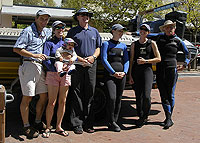
January 06 Tag Team
From the right, Brett Hobson, Tierney Thys w/Marina Hobson,
Michael Farquhar, Timony Siebert, Claire Taylor, Vince Calder
Photo by Two Oceans Staff (click for larger
image)
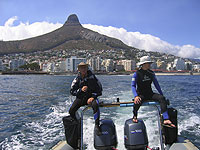
Vince and Tierney searching for sunfish.
Photo by M. Farquhar
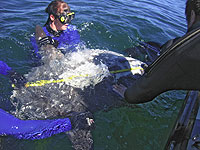
Measuring the sunfish with Timony holding
the fin. Photo by N. Townsend
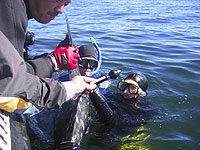
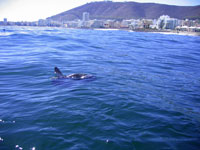
Tagged sunfish with Capetown in the background
Photo by N. Townsend

From the left: Kevin Olivier, Natasha
Townsend, Gerhard Beukes, Timony Siebert, Toshiki Matsuyama,
Kaoru Satonh. Bottom: Michael Farquhar
Photo by Kentaro Amemiya
(click
for larger image)
|
Tag Teams
In January 2006, members of the
US mola team (Tierney Thys, Brett Hobson and Marina Hobson) traveled
to Capetown, South Africa to assist Two Oceans Aquarium staff
in satellite tagging two Mola mola as part of a PADI
Project Aware Foundation grant awarded to Two Oceans.
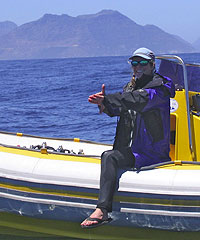
Tierney calling all molas
Photo by M. Farquhar
During this visit Thys presented
results from the 2004 South Africa tagging expedition where 2 Mola
mola yielded strong datasets. The 2004 expedition was funded
in part by National Geographic and a AAAS grant for Women's International
Science Collaboration. Thys also met with Samantha Petersen from
Birdlife International. Petersen and her fisheries observers including
Zoe McDonell have been recording large numbers of sunfish caught
as bycatch in South Africa's mid water trawling operations for
horse mackerel (Trachurus trachurus capensis). McDonell is currently
writing up these data as part of her Masters thesis with the University
of Capetown.
While the trip proved fruitful
on many accounts, tagging proved difficult. Water temps were consistently
low (hovering around 10 C) and winds were high. Only three sunfish
were encountered during the search days of January 4th-10th and
none of them proved taggable.. Tagging would have to wait until
later in the year.
On March 10th, conditions proved
perfect and the staff from Two Oceans took to the water. Water
temps were between 12 and 13 C and two good sized mola were tagged
by Mouille Point and Bantry Bay. The South African team this year
was comprised of skipper Michael Farquar, divers Claire Thomas,
Vince Calder, Timony Siebert, Gerhard Beukes, Kevin Olivier and
Zaid Manquest, photographer Natasha Townsend and Patricio Garratti
who lent vital shore support. Toshiki Matsuyama, Kentaro Amemiya
and Kaoru Satoh from Tokyo Sealife Park also joined the fun as
able assistants.
These tags are due to release on
August 24th 2006. So stay tuned!
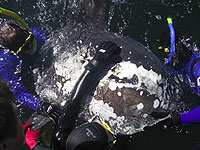
Getting ready to tag. Photo by N. Townsend
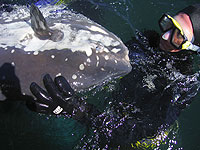
Smooch! Photo by N. Townsend
|

